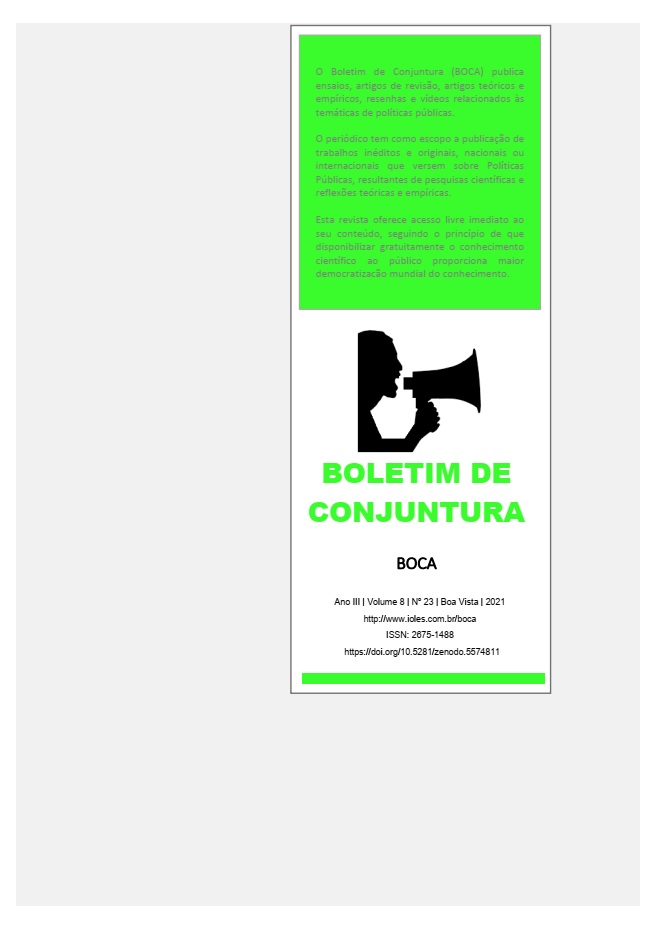COVID-19 AND CONTAMINATED WATER IN THE MUNICIPALITY OF RIO GRANDE (RS)
Main Article Content
Abstract
Recent studies have shown that SARS-CoV-2 is present in the sewage of cities, which many have problems both in the collection and treatment of sewage, being largely discharged directly into water resources. The municipality of Rio Grande/RS is an example, as in addition to presenting these problems, it has a flat topography with low drainage capacity and many occurrences of flooding and flooding on the water margins. Thus, this study aimed to analyze the current conditions of basic sanitation in this municipality and identify the main areas of concentration of discharge of contaminated water and possibly infected by Covid-19, relating to the number of cases infected with this disease in these areas. The methodology was based on a bibliographic review and data survey from the City Hall, Brazilian Institute of Geography and Statistics (IBGE) and Companhia Riograndense de Saneamento (CORSAN). The results point to the need for more installation of drainage and sewage networks due to their insufficiency, in addition to the implementation of public policies regarding the installation of infrastructure and management on the banks of water resources, and even more studies and collection of water from the points disposal of sewage and other effluents to verify the presence of SARS-CoV-2 and if there really are possibilities of contamination through the water.
Article Details

This work is licensed under a Creative Commons Attribution 4.0 International License.
Copyright (c). Conjuncture Bulletin (BOCA)
This work is licensed under a Creative Commons Attribution 4.0 International License.
References
AHMED, W. et al. “First confirmed detection of SARS-CoV-2 in untreated wastewater in Australia: A proof of concept for the wastewater surveillance of COVID-19 in the community”. Science of the Total Environment, vol. 728, 2020.
ANDERSEN, K. G. et al. “The proximalorigin of SARS-CoV-2”. Nature Medicine, vol. 26, 2020.
CUNHA, D. G. F.; CALIJURI, M. C. “Análise probabilística de ocorrência de incompatibilidade da qualidade da água com o enquadramento legal de sistemas aquáticos – estudo de caso do rio Pariquera-Açu (SP)”. Revista de Engenharia Sanitária e Ambiental, vol. 4, n. 15, 2010.
DU, Y. et al. “Formation and control of disinfection byproducts and toxicity during reclaimed water chlorination: A review”. Journal of Environmental Sciences, vol. 58, 2017.
EMPINOTTI, V. L.; BUDDS, J.; AVERSA, M. “Governance and water security: The role of the water institutional framework in the 2013–15 water crisis in São Paulo, Brazil”. Geoforum, vol. 98, 2019.
FONSECA, J. J. S. Metodologia da pesquisa científica. Fortaleza: UEC, 2002.
GIL, A. C. Métodos e técnicas de pesquisa social. São Paulo: Editora Atlas, 2008.
GUERRERO-LATORRE L. et al. “SARS-CoV-2 in river water: Implications in low sanitation countries”. Science of the Total Environment, vol. 743, November, 2020.
HOLMES, P. R. “Measuring success in water pollution control”. Water Research, vol. 12, n. 34. 1996.
HOSLETT, J. et al. “Surface water filtration using granular media and membranes: A review”. Science of the Total Environment, vol. 639, 2018.
IBGE – Instituto Brasileiro de Geografia e Estatística. “Cidades. Rio Grande/RS”. Portal Eletrônico do IBGE [2021]. Disponível em: <https://cidades.ibge.gov.br>. Acesso em: 23/09/2021.
IBGE – Instituto Brasileiro de Geografia e Estatística. “Sinopse por setor censitário do Censo 2010”. Portal Eletrônico do IBGE [2010]. Disponível em: <https://censo2010.ibge.gov.br>. Acesso em: 23/08/2021
LA ROSA, G. et al. “Primeira detecção de SARS-CoV-2 em águas residuais não tratadas na Itália”. Science of the Total Environment, vol. 736, 2020.
LING Y. et al. “Persistence and clearance of viral RNA in 2019 novel coronavirus disease rehabilitation patients”. Chinese Medical Journal, vol. 133, n. 9, 2020.
MARANHÃO, R. A.; SENHORAS, E. M. “Pacote econômico governamental e o papel do BNDES na guerra contra o novo coronavírus”. Boletim de Conjuntura (BOCA), vol. 2, n. 4, 2020.
MEDEMA, G. et al. “Presence of SARS-Coronavirus-2 RNA in Sewage and Correlation with Reported COVID-19 Prevalence in the Early Stage of Epidemic in the Netherlandas”. Environmental Science & Technology Letters, vol. 7, n. 7, 2020.
MONTEIRO, I. O. et al. “Hidrodinâmica do Saco da Mangueira: mecanismos que controlam as trocas com o estuário da Laguna dos Patos”. Revista Atlântica, vol. 27, n. 2, 2005.
NADDEO V.; LIU H. “Editorial Perspectives: 2019 novel coronavirus (SARS-CoV-2): what is its fate in urban water cycle and how can the water research community respond?” Environmental Science: Water Research & Technology, n. 6, 2020.
OLIVEIRA, C. M. “Sustainable access to safe drinking water: fundamental human right in the international and national scene”. Ambiente e Água – An Interdisciplinary Journal of Applied Science, vol. 12, n. 6, 2017.
RANDAZZO, W. et al. “Metropolitan Wastewater Analysis for COVID-19 Epidemiological Surveillance”. International Journal of Hygiene and Environmental Health, vol. 230, 2020.
RIO GRANDE. Prefeitura Municipal Quantidade de bairros atingidos por inundações e problemas relacionados. Rio Grande: Prefeitura Municipal, 2018.
RIO GRANDE. Secretaria Municipal da Saúde. Boletim Epidemiológico, setembro, 2021. Disponível em: <https://www.riogrande.rs.gov.br>. Acesso em: 26/09/2021.
ROCHA, C. H. B.; FREITAS, F. A.; SILVA, T. M. “Alterações em variáveis limnológicas de manancial de Juiz de Fora devido ao uso da terra”. Revista Brasileira de Engenharia Agrícola e Ambiental, vol. 4, n. 18, 2014.
SENHORAS, E. M. “O campo de poder das vacinas na pandemia da Covid-19”. Boletim de Conjuntura (BOCA), vol. 6, n. 18, 2021.
VAN DER HOEK, L. et al. “Identification of a new human coronavirus”. Nature Medicine, vol. 10, 2004.
WANG, X. W. et al. “Concentration and detection of SARS coronavirus in sewage from Xiao Tang Shan Hospital and the 309th Hospital of the Chinese People's Liberation Army”. Water Science and Technology, vol. 52, n. 8, 2005.
XIAO, F. et al. “Evidence for Gastrointestinal Infection of SARS-CoV-2”. Gastroenterology, vol. 158, n. 6, 2020.
XING, Y. H. et al. “Prolonged viral shedding in feces of pediatric patients with coronavirus disease 2019”. Journal of Microbiology, Immunology and Infection, vol. 53, n. 3, 2020.



